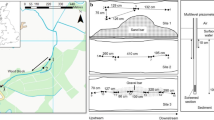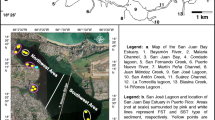Abstract
We investigated controls on stream sediment denitrification in nine headwater streams in the Kalamazoo River Watershed, Michigan, USA. Factors influencing denitrification were determined by using experimental assays based on the chloramphenicol-amended acetylene inhibition technique. Using a coring technique, we found that sediment denitrification was highest in the top 5 cm of the benthos and was positively related to sediment organic content. To determine the effect of overlying water quality on sediment denitrification, first-order stream sediments were assayed with water from second- and third-order downstream reaches, and often showed higher denitrification rates relative to assays using site-specific water from the first-order stream reach. Denitrification was positively related to nitrate (NO3 −) concentration, suggesting that sediments may have been nutrient-limited. Using stream-incubated inorganic substrata of varying size classes, we found that finer-grained sand showed higher rates of denitrification compared to large pebbles, likely due to increased surface area per volume of substratum. Denitrification was measurable on both inorganic substrata and fine particulate organic matter loosely associated with inorganic particles, and denitrification rates were related to organic content. Using nutrient-amended denitrification assays, we found that sediment denitrification was limited by NO3 − or dissolved organic carbon (DOC, as dextrose) variably throughout the year. The frequency and type of limitation differed with land use in the watershed: forested streams were NO3 −-limited or co-limited by both NO3 − and DOC 92% of the time, urban streams were more often NO3 −-limited than DOC-limited, whereas agricultural stream sediments were DOC-limited or co-limited but not frequently limited by NO3 − alone.








Similar content being viewed by others
References
Alexander, RB, Smith, RA, Schwarz, GE (2000) Effect of stream channel size on the delivery of nitrogen to the Gulf of Mexico. Nature 403: 758–761
APHA (American Public Health Association) (1995) Standard methods for the examination of water and wastewater, 19th ed. American Public Health Association, Washington, DC
Bernot, MJ, Dodds, WK, Gardner, WS, McCarthy, MJ, Sobolev, D, Tank, JL (2003) Comparing denitrification estimates for a Texas estuary by using acetylene inhibition and membrane inlet mass spectrometry. Appl Environ Microbiol 69: 5950–5956
Bölhke, JK, Harvey, JW, Voytek, MA (2004) Reach-scale isotope tracer experiment to quantify denitrification and related processes in a nitrate-rich stream, mid-continent United States. Limnol Oceanogr 49: 821–838
Brock, TD (1961) Chloramphenicol. Bacteriol Rev 25: 32–48
David, MB, Gentry, LE, Kovacic, DA, Smith, KM (1997) Nitrogen balance in and export from an agricultural watershed. J Environ Qual 26: 1038–1048
Garcia-Ruiz, R, Pattinson, SN, Whitton, BA (1998a) Denitrification and nitrous oxide production in sediments of the Wiske, a lowland eutrophic river. Sci Total Environ 210–211: 307–320
Garcia-Ruiz, R, Pattinson, SN, Whitton, BA (1998b) Denitrification in river sediments: relationship between process rate and properties of water and sediment. Freshw Biol 39: 467–476
Goolsby, DA, Battaglin, WA, Aulenbach, BT, Hooper, RP (2001) Nitrogen input to the Gulf of Mexico. J Environ Qual 30: 329–336
Groffman, PM, Boulware, NJ, Zipperer, WC, Pouyat, RV, Band, LE, Colosimo, MF (2002) Soil nitrogen cycle processes in urban riparian zones. Environ Sci Technol 36: 4547–4552
Hedin, LO, von Fischer, JC, Ostrom, NE, Kennedy, BP, Brown, MG, Robertson, GP (1998) Thermodynamic constraints on nitrogen transformations and other biogeochemical processes at soil–stream interfaces. Ecology 79: 684–703
Hill, AR, Devito, KJ, Campagnolo, S, Sanmugadas, K (2000) Subsurface denitrification in a forest riparian zone: interactions between hydrology and supplies of nitrate and organic carbon. Biogeochemistry 51: 193–223
Inwood, SE, Tank, JL, Bernot, MJ (2005) The influence of land use on sediment denitrification in 9 midwestern streams. J N Am Benthol Soc 24: 227–245
Kemp, MJ, Dodds, WK (2002a) Comparisons of nitrification and denitrification in prairie and agriculturally influenced streams. Ecol Appl 12: 998–1009
Kemp, MJ, Dodds, WK (2002b) The influence of ammonium, nitrate, and dissolved oxygen concentrations on uptake, nitrification, and denitrification rates associated with prairie stream substrata. Limnol Oceanogr 47: 1380–1393
Knowles, R (1982) Denitrification. Microbiol Rev 46: 43–70
Laursen, A, Seitzinger, SP (2003) Measurement of denitrification in rivers: an integrated whole reach approach. Hydrobiologia 485: 67–81
Lauver, L, Baker, LA (2000) Mass balance for wastewater nitrogen in the Central Arizona–Phoenix ecosystem. Water Res 34: 2754–2760
Livingstone, MW, Smith, RV, Laughlin, RJ (2000) A spatial study of denitrification potential of sediments in Belfast and Strangford loughs and its significance. Sci Total Environ 251–252: 369–380
Martin, LA, Mulholland, PJ, Webster, JR, Valett, HM (2001) Denitrification potential in sediments of headwater streams in the southern Appalachian Mountains, USA. J N Am Benthol Soc 20: 505–519
McIsaac, GF, David, MB, Gertner, BZ, Goolsby, DA (2001) Nitrate flux in the Mississippi River. Nature 414: 166–167
Mitsch, WJ, Day, JW Jr, Gilliam, W, Groffman, PM, Hey, DL, Randall, GW, Wang, N (2001) Reducing the nitrogen loading to the Gulf of Mexico from the Mississippi River Basin: strategies to counter a persistent ecological problem. Bioscience 51: 373–388
Mulholland, PJ, Valett, HM, Webster, JR, Thomas, SA, Cooper, LW, Hamilton, SK, Peterson, BJ (2004) Stream denitrification and total nitrate uptake rates measured using a field 15N tracer addition approach. Limnol Oceanogr 49: 809–820
Pattinson, SN, Garcia-Ruiz, R, Whitton, BA (1998) Spatial and seasonal variation in denitrification in the Swale–Ouse system, a river continuum. Sci Total Environ 210–211: 289–305
Peterson, RJ, Wollheim, WM, Mulholland, PJ, Webster, JR, Meyer, JL, Tank, JL, Marti, E, Bowden, WB, Valett, HM, Hershey, AE, McDowell, WH, Dodds, WK, Hamilton, SK, Gregory, S, Morrall, DD (2001) Control of N export from watershed by headwater streams. Science 292: 86–90
Richardson, WB, Strauss, EA, Bartsch, LA, Monroe, EM, Cavanaugh, JC, Vingum, L, Soballe, DM (2004) Denitrification in the Upper Mississippi River: rates, controls, and contribution to nitrate flux. Can J Fish Aquat Sci 61: 1102–1112
Risgaard-Petersen, N (2003) Coupled nitrification–denitrification in autotrophic and heterotrophic estuarine sediments: on the influence of benthic microalgae. Limnol Oceanogr 48: 93–105
Royer, TV, Tank, JL, David, MB (2004) Transport and fate of nitrate in headwater agricultural streams in Illinois. J Environ Qual 33: 1296–1304
Schaller, JL, Royer, TV, David, MB, Tank, JL (2004) Denitrification in plant beds and benthic sediments of an agricultural stream and its effect on a nitrogen budget. J N Am Benthol Soc 23: 667–676
Seitzinger, SP (1988) Denitrification in freshwater and coastal marine ecosystems: ecological and geochemical significance. Limnol Oceanogr 33(2): 702–724
Seitzinger, SP, Styles, RV, Boyer, EW, Alexander, RB, Billen, G, Howarth, RW, Mayer, B, van Breeman, N (2002) Nitrogen retention in rivers: model development and application to watersheds in the northeastern USA. Biogeochem 57–58: 199–237
Smith, MS, Tiedje, JM (1979) Phases of denitrification following oxygen depletion in soil. Soil Biol Biochem 11: 261–267
Tank, JL, Dodds, WK (2003) Nutrient limitation of epilithic and epixylic biofilms in ten North American streams. Freshw Biol 48: 1031–1049
Tiedje, JS (1982) Denitrification. In: Page, AL (Ed.) Methods of Soil Analysis, Part II, American Society of Agronomy, Madison, WI, pp 1011–1026
Tiedje, JS, Groffman, PM (1989) Perspectives on measurement of denitrification in the field including recommended protocols for acetylene based methods. In: Clarholm, M, Bergström, L (Eds.) Ecology of Arable Land, Kluwer Academic Publishers, Amsterdam, pp 217–240
USEPA (United States Environmental Protection Agency) (1993) The determination of inorganic anions in water by ion chromatography. Method 300.0. Cincinnati, Ohio
van Breeman, N, Boyer, EW, Goodale, CL, Jaworski, NA, Paustian, K, Seitzinger, SP, Lajtha, K, Mayer, B, van Dam, D, Howarth, RW, Nadelhoffer, KJ, Eve, M, Billen, G (2002) Where did all the nitrogen go? Fate of nitrogen inputs to large watersheds in the northeastern USA. Biogeochemistry 57–58: 267–293
Vitousek, PM, Aber, JD, Howarth, RW, Likens, GE, Matson, PA, Schindler, DW, Schlesinger, WH, Tilman, DG (1997) Human alteration of the global nitrogen cycle: sources and consequences. Ecol Appl 7: 737–750
Wall, L (2003) Spatial and temporal variability of sediment denitrification within an agriculturally influenced reservoir. Master’s thesis, University of Notre Dame, Notre Dame, Indiana
Wang, F, Juniper, SK, Pelegri, SP, Macko, SA (2003) Denitrification in sediments of the Laurentian Trough, St. Lawrence Estuary, Quebec, Canada. Estuar Coast Shelf Sci 57: 515–522
Westerhoff, P, Aiken, G, Gary, G, Debroux, J (1999) Relationships between the structure of natural organic matter and its reactivity towards molecular ozone and hydroxyl radicals. Water Res 33: 2265–2276
Zumft, WG (1997) Cell biology and molecular basis of denitrification. Microbiol Mol Biol Rev 61: 533–616
Acknowledgments
We thank Lareina Wall and Todd Royer for helpful comments on rate calculations and early drafts of the manuscript; Clay Arango for GIS support, Jake Beaulieu, Denise Bruesewitz, Laura Taylor, and Josh Inwood for field assistance. This research was funded in part by USDA-CSREES 2001-35102-10778 and NSF-DEB 0111410.
Author information
Authors and Affiliations
Corresponding author
Rights and permissions
About this article
Cite this article
Inwood, S.E., Tank, J.L. & Bernot, M.J. Factors Controlling Sediment Denitrification in Midwestern Streams of Varying Land Use. Microb Ecol 53, 247–258 (2007). https://doi.org/10.1007/s00248-006-9104-2
Received:
Revised:
Accepted:
Published:
Issue Date:
DOI: https://doi.org/10.1007/s00248-006-9104-2




